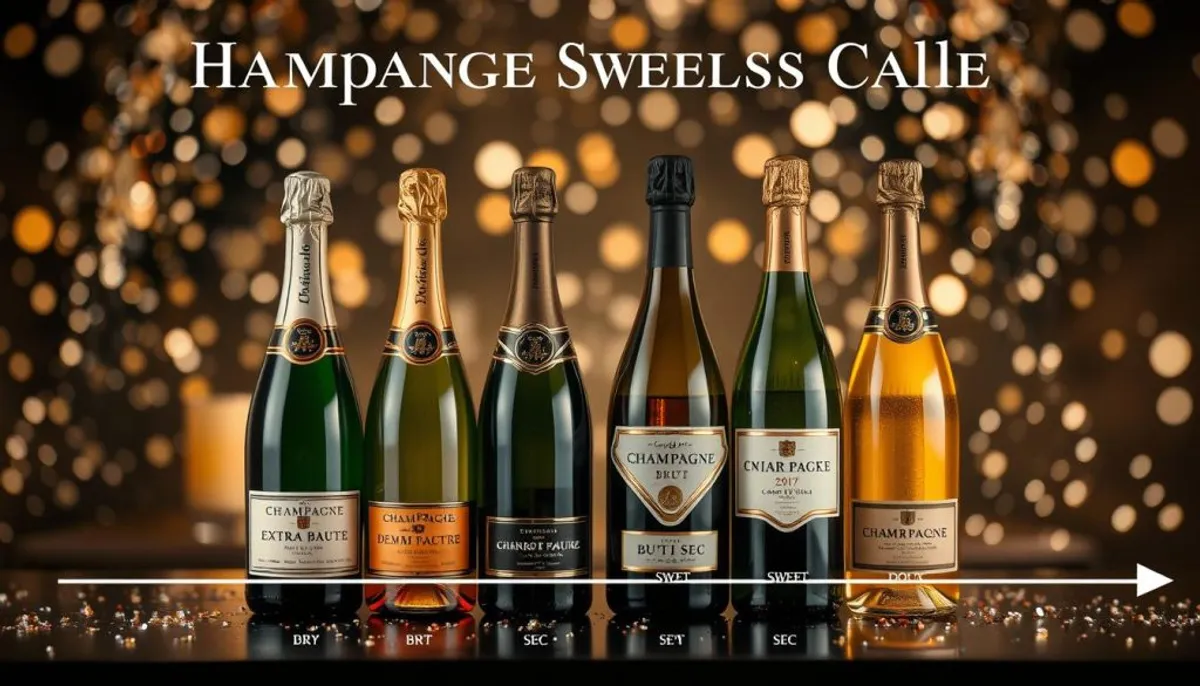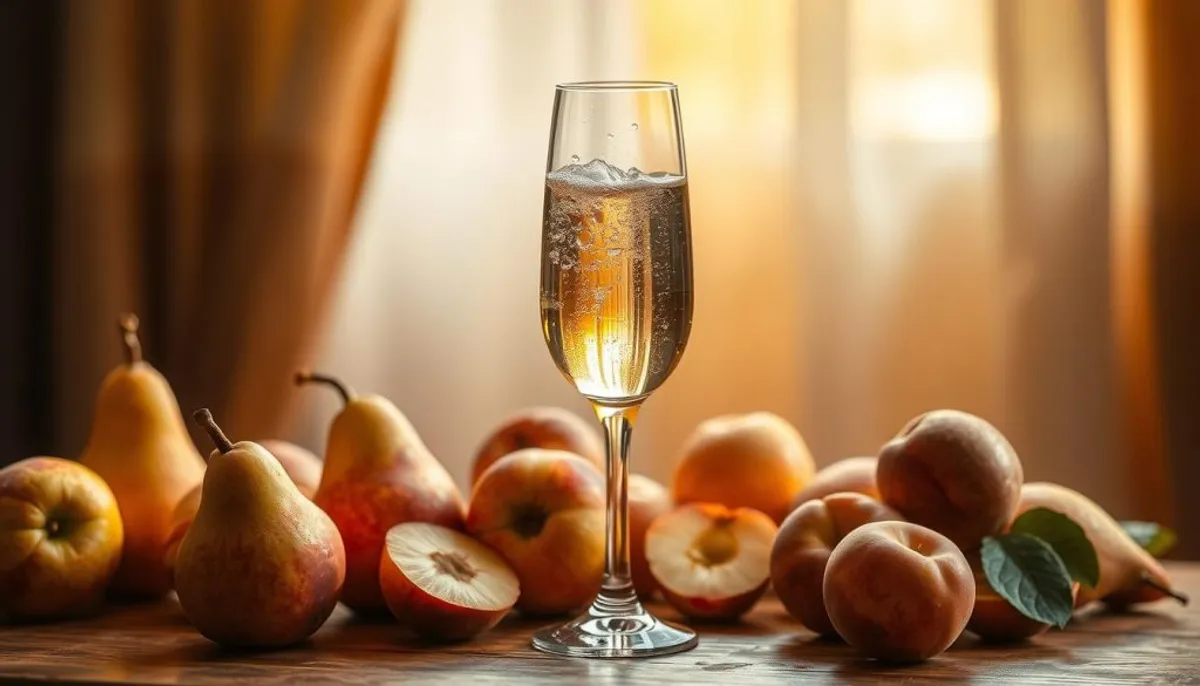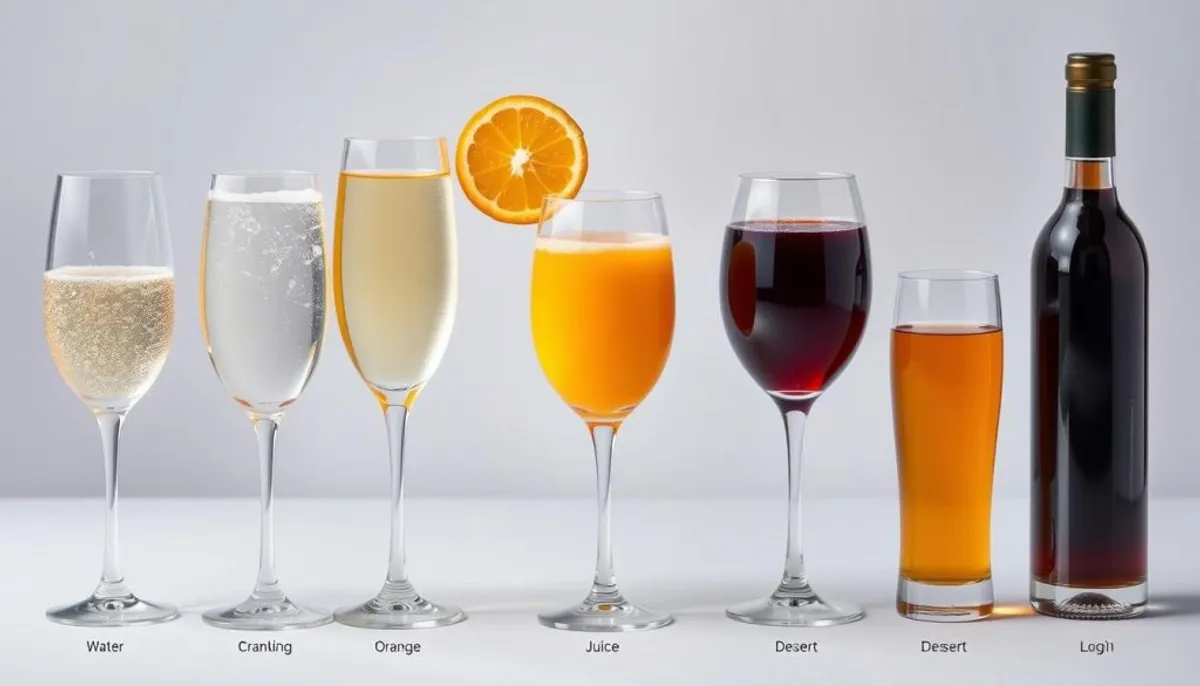Exploring the realm of Champagne sweetness reveals a spectrum of flavors, from the driest to the most lusciously sweet. Brut Demi Sec, with its sweeter profile, stands out as a distinct choice for specific occasions and pairings. It offers a unique taste experience that caters to those who seek a balance between dryness and sweetness.
The essence of Champagne’s sweetness lies in the ‘liqueur d’expédition’ added before corking. This process, known as dosage, is pivotal in shaping the final taste. The spectrum of sweetness in Champagne spans from the driest Brut Nature to the sweetest Doux, with Brut Demi Sec occupying a middle ground.

Brut Demi Sec boasts a sugar content of 32-50 grams per liter. This moderate sweetness makes it an excellent match for a variety of dishes, including spicy meals, creamy cheeses, and fruit-based desserts. It appeals to those who prefer a noticeable sweetness without the extreme sweetness found in Doux.
Key Takeaways
- Brut Demi Sec is a sweeter style of Champagne
- Sweetness in Champagne comes from the ‘liqueur d’expédition’
- Brut Demi Sec contains 32-50 grams of sugar per liter
- It pairs well with spicy foods, creamy cheeses, and fruit desserts
- Champagne sweetness levels range from Brut Nature to Doux
The Origins of Champagne Sweetness Classification
Champagne history is a tapestry of innovation, notably in the realm of sweetness classification. The evolution of sugar in winemaking was a response to the diverse preferences of consumers across French wine regions.
Historical Development of Sweetness Scales
In Champagne’s early days, wines were significantly sweeter than those of today. As consumer tastes evolved, a scale to categorize sweetness levels was developed. This scale spans from Brut Nature, with 0-3 grams of sugar per liter, to Doux, with over 50 grams.
The Role of Sugar in Champagne Production
Sugar is essential in balancing Champagne’s high acidity. The cold climate of the Champagne region often yields grapes with lower sugar content. To round out the flavor and achieve desired sweetness, winemakers add a dosage, a blend of wine and sugar.
Regional Influences on Sweetness Levels
The Champagne region’s various areas contribute distinct characteristics to the wines. The Côte des Blancs is renowned for Chardonnay grapes, while the Montagne de Reims is celebrated for Pinot Noir. These regional differences in grape varieties and terroir affect natural sugar levels, ultimately shaping the final sweetness classification of each Champagne.
| Sweetness Level | Sugar Content (g/L) | Typical Style |
|---|---|---|
| Brut Nature | 0-3 | Very dry |
| Extra Brut | 0-6 | Bone dry |
| Brut | 0-12 | Dry |
| Extra Sec | 12-17 | Off-dry |
| Sec | 17-32 | Medium sweet |
| Demi-Sec | 32-50 | Sweet |
| Doux | 50+ | Very sweet |
From Brut Nature to Doux: Complete Sweetness Scale
Champagne’s sweetness levels cater to a wide range of tastes. The spectrum begins with Brut Nature, which contains 0-3 grams of sugar per liter. It ends with Doux, which boasts over 50 grams. This spectrum showcases the varied sparkling wine sugar content preferences among consumers.
Brut, the most favored style, accounts for 80-90% of Champagne sales. It has less than 12 grams of sugar per liter, roughly half a teaspoon in a 5-ounce serving. Extra Brut, situated between Brut Nature and Brut, contains 0-6 grams per liter.
As we ascend the sweetness scale, we encounter Extra Dry (12-17 g/L), Sec (17-32 g/L), and Demi-Sec (32-50 g/L). Doux, the sweetest, contains over 50 grams per liter. It is perfect for dessert pairings.
| Sweetness Level | Sugar Content (g/L) | Characteristics |
|---|---|---|
| Brut Nature | 0-3 | Bone dry, no added sugar |
| Extra Brut | 0-6 | Very dry, minimal sweetness |
| Brut | 0-12 | Dry, most common style |
| Extra Dry | 12-17 | Slightly sweet |
| Sec | 17-32 | Noticeably sweet |
| Demi-Sec | 32-50 | Sweet |
| Doux | 50+ | Very sweet, dessert-like |
The dosage in Champagne is key to determining these sweetness levels. It’s not merely about sweetness preference; dosage also balances the natural acidity of Champagne grapes. This balance is what creates the unique flavor profiles that make each style distinct and appealing to different tastes.
What Makes Brut Demi Sec Unique
Brut Demi Sec distinguishes itself in the sparkling wine realm with its unique sweetness profile. This variety of sweet Champagne strikes a perfect balance between crispness and sweetness. Additionally, it pairs beautifully with a refreshing leger spritz cocktail, making it ideal for a wide range of occasions.
Sugar Content Range
Brut Demi Sec boasts a sugar content of 32 to 50 grams per liter. This places it squarely in the sweet Champagne category. It offers a noticeable sweetness without dominating the palate. In comparison to drier styles like Brut or Extra Brut, Brut Demi Sec provides a more indulgent experience.
Flavor Profile Characteristics
The taste of Brut Demi Sec is marked by a harmonious mix of fruit flavors and sweetness. It typically features notes of ripe peaches, apricots, and honey, complemented by a refreshing acidity. This dessert sparkling wine retains a crisp finish, ensuring a balanced tasting experience.

Ideal Serving Occasions
Brut Demi Sec excels as a dessert wine, pairing wonderfully with fruit-based desserts, pastries, and mild cheeses. It’s an excellent choice for celebrations, offering a sweeter alternative to traditional dry Champagnes. This versatile sparkling wine is perfect for those who prefer a touch of sweetness in their bubbly. It can be enjoyed as an aperitif or as a delightful conclusion to a meal.
The Science Behind Champagne Sweetness
The winemaking process is pivotal in shaping Champagne’s sweetness. Each step, from fermentation to dosage, influences the taste. This intricate process culminates in the final product’s flavor profile.
Fermentation Process Impact
Champagne’s creation involves two fermentation stages. The initial fermentation occurs in tanks, followed by a second in bottles. This method is responsible for the wine’s characteristic bubbles and complexity. During fermentation, yeast transforms sugar into alcohol and carbon dioxide.
Dosage and Its Effects
The dosage, added post-second fermentation, adjusts the Champagne’s sweetness. The sugar content in the dosage dictates the wine’s final sweetness. For example, Brut Nature has 0-3 grams of sugar per liter, while Doux can exceed 50 grams.
| Sweetness Level | Sugar Content (g/L) |
|---|---|
| Brut Nature | 0-3 |
| Extra Brut | 0-6 |
| Brut | 0-12 |
| Demi-Sec | 32-50 |
| Doux | 50+ |
Climate Influence on Sugar Levels
The terroir significantly affects Champagne. The cool climate leads to grapes with higher acidity. To counterbalance this, winemakers adjust sugar levels. This balance of sweetness and acidity defines Champagne’s unique taste.
Grasping the scientific aspects of Champagne production enhances our appreciation for its craftsmanship. From the vineyard to your glass, every step in the winemaking process contributes to the final product’s distinct character and sweetness.
Caloric and Carbohydrate Content Across Sweetness Levels
Grasping the nuances of champagne calories and the nutritional profile of sparkling wines is essential for those aiming for low-carb wine choices. The sweetness level of champagne significantly influences its caloric and carbohydrate content. This section delves into how these metrics vary across different sweetness categories.
Brut Nature, the most austere champagne, boasts minimal sugar. A 5-ounce serving harbors approximately 90 calories and less than 1 gram of carbs. As we ascend the sweetness spectrum, Brut champagne presents a slight increase, with 95 calories and roughly 1.5 grams of carbs per serving.
Demi-Sec, a notably sweeter variant, carries more calories and carbs. A 5-ounce pour is expected to contain about 120 calories and 5-7 grams of carbs. Doux, the sweetest tier, can have over 130 calories and 8 grams of carbs per serving.
| Sweetness Level | Calories (5 oz) | Carbs (g) |
|---|---|---|
| Brut Nature | 90 | 0-1 |
| Brut | 95 | 1-2 |
| Demi-Sec | 120 | 5-7 |
| Doux | 130+ | 8+ |
For those mindful of their calorie consumption, opting for drier styles like Brut Nature and Brut is advisable. These selections enable you to savor the refined taste of champagne while adhering to a diet that promotes balance. Additionally, if you're looking to elevate your gatherings, consider a luxury event service to enhance your experience.
Comparing Champagne Sugar Levels to Other Beverages
Champagne emerges as a low-sugar choice in the realm of beverages. This distinction becomes apparent when comparing it to other popular drinks, both alcoholic and non-alcoholic. Additionally, consumers can find discounted sampen offers that highlight various champagne selections.
Wine Comparisons
The sugar content in champagne varies with its style. Brut Nature, for instance, contains 0-3 grams of sugar per liter. On the other end, Doux can have more than 50 grams. A standard 5-ounce glass of Brut Champagne contains approximately 1.5 grams of sugar. This is less than some dry table wines, which may have even less sugar. When considering champagne, it's also important to take into account luxury champagne pricing, as it can vary significantly based on the brand and quality.
Popular Cocktails Sugar Content
The sugar content in cocktails can vary greatly. A Vodka Soda, for example, contains no sugar, making it a low-sugar option. Yet, other well-liked cocktails have higher sugar levels:
- Gin & Tonic: 14g of sugar
- Margarita (with simple syrup): 20g of sugar
- Rye & Coke: 33g of sugar
Non-Alcoholic Beverage Comparison
Even non-alcoholic beverages can have surprising sugar levels:
- Honest Tea Green Tea: 16g of sugar
- Starbucks 2% Milk Grande Latte: 17g of sugar

This comparison underscores champagne as a lower-sugar alternative among various beverages. Whether you’re mindful of sugar intake or simply curious about the sugar content in cocktails, understanding these differences aids in making informed choices about your drink preferences.
Selecting the Right Sweetness Level for Your Palate
Choosing the perfect champagne sweetness level is crucial for a memorable sparkling wine experience. Your personal wine preferences significantly influence this choice. Let’s dive into the sweetness spectrum to guide you in selecting the right champagne during your next tasting.
For aficionados of dry wines, Brut Nature and Extra Brut are top choices. Brut Nature boasts only 3 grams of sugar per liter, while Extra Brut contains up to 6 grams. These styles highlight the wine’s natural essence, devoid of added sweetness.
Brut champagne, with up to 12 grams of sugar per liter, strikes a balance. It’s a versatile option that complements a wide range of foods and events. If you seek a touch of sweetness, Extra Dry (12-17 grams/liter) could be your perfect match.
For those with a penchant for sweetness, consider these alternatives:
- Sec: 17-32 grams of sugar per liter
- Demi-Sec: 32-50 grams of sugar per liter
- Doux: Over 50 grams of sugar per liter
Personal taste is inherently subjective. It’s wise to experiment with various styles to find your favorite. Consider the event’s nature and the food you’ll be serving when making your choice. A champagne tasting event is an ideal platform to explore different sweetness levels and refine your taste preferences.
Food Pairing Guidelines for Different Sweetness Levels
Mastering the art of Champagne food pairing elevates your dining experience to new heights. The essence lies in harmonizing the sweetness levels of the Champagne with the flavors of the dishes. Let’s dive into some delectable pairings.
Appetizer Pairings
Extra Brut Champagne’s dry, crisp nature is a perfect match for raw seafood and light salads. For a quintessential beginning, consider pairing oysters with a bone-dry Zero Dosage Champagne. On the other hand, Brut Nature complements salty appetizers such as caviar or fried potatoes, striking a balance with their richness.
Main Course Matches
Sec Champagne’s adaptability is evident in its pairing with main courses. It excels with spicy dishes and creamy sauces. A mushroom risotto or lentil curry pairs well with it. For grilled vegetable skewers, opt for a Brut or Extra Brut. Rosé Champagne, with its fruity undertones, complements a quinoa salad nicely.
Dessert Combinations
Demi-Sec and Doux Champagnes are the go-to choices for dessert wines. Demi-Sec harmonizes with fruit-based desserts and bold cheeses. For those with a sweet tooth, Doux Champagne is ideal with rich chocolate cakes or truffles. It also pairs well with caramel-based treats and ice cream.
Wine and cheese pairings extend beyond still wines. A creamy Brie or Camembert, when paired with a crisp Brut Champagne, creates a sumptuous taste experience.
Conclusion
Embarking on the exploration of Champagne is a thrilling adventure for those passionate about wine. This journey uncovers the delicate harmony of sweetness levels, ranging from Brut to Demi-Sec. Brut Champagne, boasting less than 12 grams of sugar per liter, is the preferred choice in France. It complements seafood and starters, ideal for those who prefer a drier taste.
Demi-Sec Champagne, with its 32 to 50 grams of sugar per liter, presents a sweeter experience. Despite its rarity, making up only 1.5% of France’s Champagne output, it is a versatile choice for spicy dishes and desserts. This guide underscores the importance of grasping these distinctions to refine your wine selection.
Whether you’re orchestrating a grand event or a simple dinner, understanding Champagne’s sweetness levels is crucial. From Brut’s crisp notes to Demi-Sec’s honey-like flavors, there’s a Champagne for every taste and celebration. As you continue your exploration, remember that the ideal Champagne selection is a blend of personal taste, food pairings, and the essence of your occasion.
RelatedRelated articles



